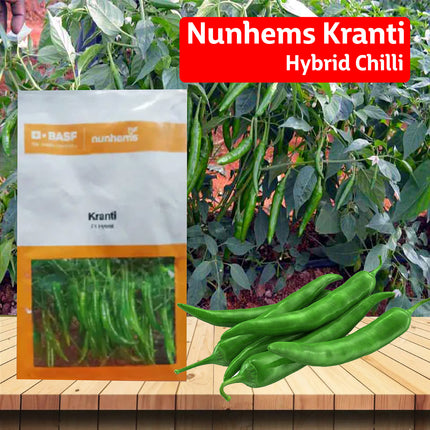Description
Nunhems Kranti is a hybrid chilli variety developed by BASF and marketed by Nunhems India. It is a high-yielding variety with good heat tolerance and resistance to diseases such as anthracnose and bacterial wilt. Kranti has a long shelf life and is suitable for both fresh and processed markets.
Key features:
-
High yield: Kranti can produce up to 5000-6000 kg of chillies per hectare.
-
Good heat tolerance: Kranti can withstand temperatures up to 45 degrees Celsius.
-
Disease resistance: Kranti is resistant to anthracnose and bacterial wilt.
-
Long shelf life: Kranti has a long shelf life of up to 2 weeks.
-
Suitable for fresh and processed markets: Kranti is suitable for both fresh and processed markets.
Benefits:
-
High yield
-
Good resistance to pests and diseases
-
Dual-purpose (green fresh, red dry)
-
Moderately hot
-
Suitable for a wide range of climates
-
Easy to grow
Land Preparation:
-
Number of ploughings: 2-3 ploughings are generally recommended to achieve a fine tilth.
-
Depth of ploughing: The first ploughing should be deep (18-20 cm) to break the hardpan and improve drainage. Subsequent ploughings can be shallower (10-12 cm).
-
Timing: Ploughing is best done during the summer months (April-May) to allow the soil to dry and aerate.
-
Moisture content: Ideally, the soil should have moderate moisture content during ploughing. Avoid ploughing when the soil is too wet or dry.
-
After ploughing, remove all weeds, stones, and other debris from the field. This will prevent competition for resources and facilitate smooth land levelling.
-
Incorporate well-decomposed farmyard manure (FYM) or compost at 15-20 tons per acre at the time of final ploughing. This improves soil fertility, water-holding capacity, and soil structure.
-
Incorporate well-decomposed farmyard manure (FYM) or compost at 15-20 tons per acre at the time of final ploughing. This improves soil fertility, water-holding capacity, and soil structure.
-
Apply a basal dose of fertilizers based on soil test recommendations. A general recommendation is 40 kg nitrogen, 60 kg phosphorus, and 40 kg potassium per acre.
Sowing
-
Sow Nunhems Kranti Chilli seeds in a well-drained seedbed with fertile soil.
-
Sow seeds thinly, about 2-3 cm (about 1.18 in) apart.
-
Cover the seeds lightly with the soil.
-
Water the seedbed regularly and keep it moist.
-
Nunhems Kranti Chilli Seedlings should emerge in 7-10 days.
Transplanting:
-
Transplant Chilli seedlings to the field when they are 4-5 weeks old and have 4-5 true leaves.
-
Harden off seedlings for a week before transplanting by gradually exposing them to outdoor conditions.
-
Prepare the field by tilling, levelling, and making planting holes.
-
Space the plants 45-60 cm apart in rows 60-75 cm apart.
-
Make sure the roots are not bent when planting.
-
Water the plants thoroughly after transplanting.
Harvesting:
-
Nunhems Meenal Chillies are ready for harvest when they reach full colour and size.
-
Ripe Nunhems Kranti Chilli
-
Use sharp scissors or pruners to harvest the chillies.
-
Cut the stem about 1 cm above the fruit.
-
Harvest chillies regularly, as this will encourage further fruiting.
Storage:
-
Fresh Chilli can be stored in the refrigerator for up to 2 weeks.
-
Nunhems Kranti Chilli stored in refrigerator
-
Wash chillies gently before storing them.
-
Place Chillis in a plastic bag and remove as much air as possible.
-
Alternatively, chillies can be dried or frozen for longer storage.
Drying of Nunhems Kranti Chilli:
-
Wash chillies and remove stems.
-
Slice chillies into thin strips or leave them whole.
-
Spread chillies on a clean drying rack or trays in a well-ventilated area.
-
Drying chillies
-
Turn chillies regularly to ensure even drying.
-
Chillies are dry when they are brittle and break easily.
